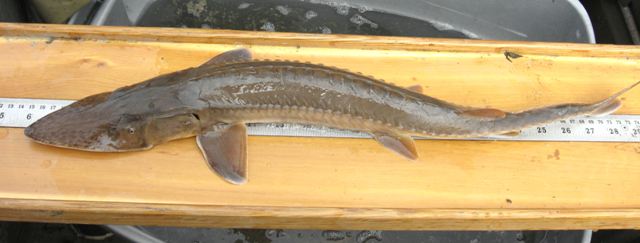Shovelnose Sturgeon
(Scaphirhynchus platorynchus )

The damming of large rivers has contributed significantly to the decline of the shovelnose sturgeon by blocking access to ancestral spawning areas and greatly reducing its required habitat. The lack of pollution laws and increased siltation from changing land use patterns in the watershed also negatively impacted habitat and its primary food source of mussels and snails.
Description
The shovelnose sturgeon is a native species and is the smallest sturgeon species found in North America. Their snout is broad and flat which gives them the name "shovelnose". Their body is covered in armored plates rather than scales. The only other similar species in Ohio is the lake sturgeon.
Habitat and Habits
The shovelnose sturgeon is a large river species that prefers sand and gravel substrates with rather fast current. Historically they were abundant in the Ohio River all the way upstream to the Pennsylvania line. They steadily decreased in abundance in the Ohio River after 1910 when the present day lock and dam system was first constructed. Today they are a rare find in Ohio. Small numbers of shovelnose sturgeon can still be found in the Ohio River from Portsmouth to the Indiana line and in the lower Scioto River. If captured they must be released immediately because of their endangered status.
Reproduction and Care of the Young
The largest females produce a maximum of 50,000 eggs. Spawning occurs over gravel substrates in swift current from April through June when water temperatures range from 65 to 70 °F. Female shovelnose sturgeon are reported to reach sexual maturity at five to seven years of age and do not spawn every year. Aging studies from the Mississippi River report fish greater than age 12 are rare. This suggests that most female shovelnose sturgeon likely spawn only three to four times in their life. Young sturgeon hatched in the spring reach lengths of six to eight inches by October of their first year.